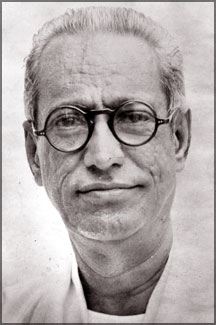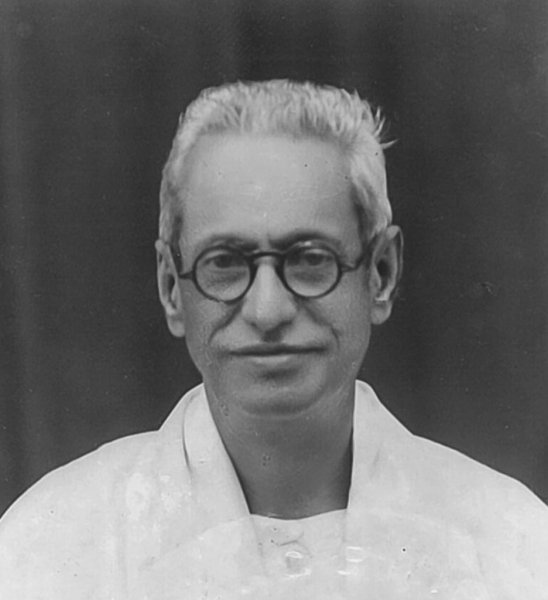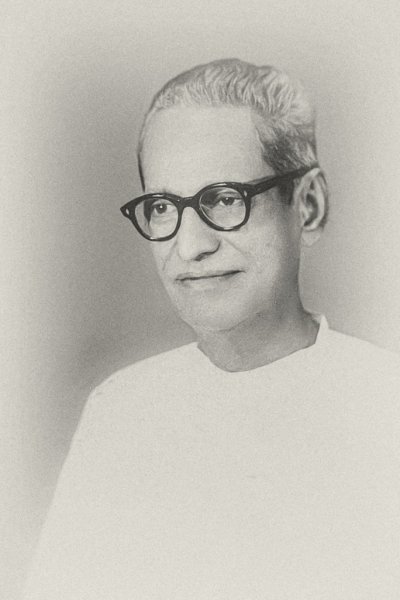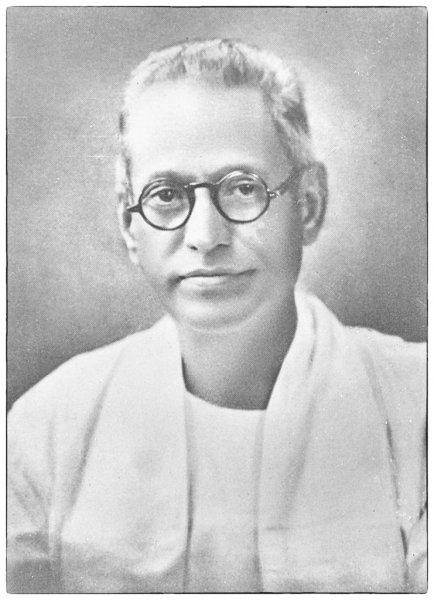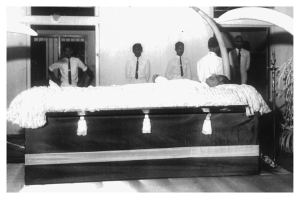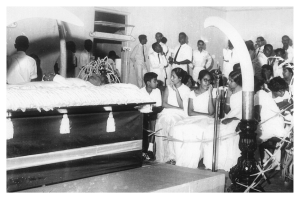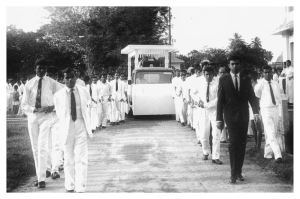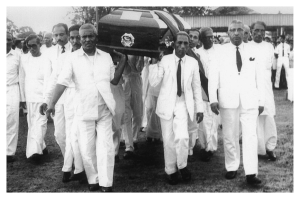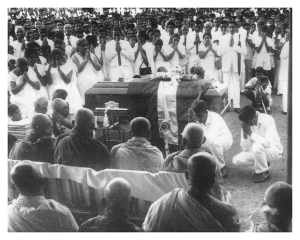L. H. Mettananda (1894 -1967)
An educationist and patriot par excellence.
Published in the Sunday Standard Nov 19 2006
by Ramani D.Wickramaratne
First November 2006 marked the 39th death anniversary of Mr. L.H. Mettananda – educationist, humanist, nationalist and Buddhist revivalist. Even after 39 long years, his very name brings about a deep feeling of reverence for this exemplary “Lanka Puthra.” The more one reads about him, the more one is amazed at the quality and quantum of work that one human being has accomplished during a lifetime! In an article Mr. D. B. Dhanapala wrote about Mr. Mettananda in The Island of 3rd November 2004 he refers to him thus:” In his person he combines the force, of more than half a dozen Buddhist Congresses and a hundred Y.M.B.As all put together.” Through his commitment and dedication in the field of education, he has left behind a legacy hard to match by others. While stating this, it needs to be emphasized, that those who fitted into the same category of bygone eras, are few and far between. All this has been done purely and truly, as a “committed service” to the nation, never for his own personal glory or monetary benefit. Such personalities are indeed an extremely rare phenomenon in the current Sri Lankan society. This is why it is so important for the citizens of this country, especially those in the field of education to know and understand the personality of the late Mr.L.H.Mettananda and understand what exactly the country expects of them. It seems that words cannot do adequate justice to a personality such as him.
Mr. Lokusatu Hewa Mettananda was born on 19th March 1894 at Kaluwadumulla, Ambalangoda as the eldest son of L.H.Kovies De Silva a businessman and Weerasooriya Karalinahamy. He had four brothers and one sister. He had his primary education at Dharmasoka College- Ambalangoda, his secondary education at Richmond College-Galle where he had a distinguished academic record. In 1912 he passed the Cambridge Senior Examination and in 1913 he successfully completed the London Matriculation examination. During the period 1914-1915 he studied at the Teacher’s Training College-Colombo. In July 1930, he obtained the Diploma in Education from the London Day Training College and continued to study for a Masters’ Degree in Education. In between these years he joined the tutorial staff of Sri Sumangala Boy’s School-Panadura in 1912 and served as an Assistant Teacher at Holy Cross College-Kalutara during the years 1916-1918. He joined Ananda College as an Assistant Teacher in 1919 and the Buddhist Theosophical Society(BTS) selected him to become the first Principal at Nalanda Vidyalaya in 1923, which was a new school.
In 1923 Mr. Mettananda married Celia, daughter of Mudliyar J.De S.Wickremesooriya. They had three sons and two daughters all of whom have done justice to their late father by qualifying academically and becoming useful citizens of Sri Lanka. The heavy work schedule which involved school work, social service, as well as Buddhist work did not hamper too much Mr. Mettananda’s duties as husband and father. Time permitting, he coordinated all these duties and responsibilities as best as he could. No doubt, the children would have loved to have their father’s company more, but his sense of “service to the country ” did not permit him to be selfish. Thirty- nine years after his death, his children as well as their partners still talk with a lot of love, affection and reverence when referring to their late father and father-in-law. This indeed is also a rather rare phenomenon in modern Sri Lanka! On 5th November, which was Poya Day, they organized a Bana sermon delivered by the Ven. Vijitha Thera of Issipathanaramaya Temple, to offer merit in memory of Mr. Mettananda.
His personality
Those who knew Mr. Mettananda well, respected him as a man who had five basic principles which guided him through life. They were: (1) he never sought personal gains; (2) never amassed unnecessary wealth; (3) never made irresponsible statements; (4) always safeguarded democracy; (5) lived a simple lifestyle.
He was indeed a remarkable personality who, as a principled Buddhist was fearless and forthright, selfless, committed and dedicated to the well-being of the nation, a “Kalyana Mithra” (good friend), honest and disciplined, diplomatic and tactful, just and fair to all.
It was rare indeed, for one personality to possess such exemplary qualities but these were absolutely necessary for the life he chose for himself and his family. He set the same examples & standards for his own children, as well as other children. The fact that he was able to mix with a wide spectrum of society and gain their respect alone bears testimony, to the fact that he deserved every bit of the respect he commanded. These qualities helped him to get the support he needed to carry on his mission in life.
His service to the nation
His service to the nation was many facetted and equally amazing in achievements purely because of the high standards he set for himself and those around him. They can be categorized into three main areas as stated below. Having read through them, one will surely feel a sense of awe and amazement at whether it was humanly possible for one individual to be all this and more!
Education
It could be said of Mr. Mettananda, that his first love was education. It is evident from documents available, to see how much time and energy he spent in each school he worked, to find ways and means of implementing an environment which was conducive for children to gain maximum benefits to widen their horizons in knowledge, sports, service to others during their school life. Discipline was absolutely essential and he took great pains to instill discipline in the students at every school he worked. In each school he taught or became Principal, he encouraged students from the outstations, to study Science and to qualify as doctors or engineers.
During the period he was Acting Principal of Ananda College (1932-1936) and Principal (1945-1955), he improved the standard of education and the curriculum to be practical and constructive. Instead of punishing students for misdeeds, he taught them to be responsible and self-reliant. He was of the strong opinion that children must be conversant in both Sinhala and Tamil and therefore, made them compulsory subjects for grades 1 and 2 at Ananda College. He was also of the opinion that English must be taught to students for them to be able to use it fluently in later life, when they go out into society and the world at large. He himself taught Latin and English for four years at Ananda College. Under him, education was based on Buddhist traditions and the mother tongue was used as the medium of instruction. He introduced handicrafts and gardening as subjects and also introduced vocational training subjects such as carpentry, book binding and iron works to enable students to appreciate manual work and vocational education.
During his time at Ananda, he improved the library facilities and encouraged students to read as a method of enhancing knowledge and also personally supervised the building of the school Science Laboratory which is being used (as it was then) even today. It was also during his time that the foundation for the Ananda Viharaya, the extension to the existing school hostel (soft opening was in 1954) saw the light of day and the Parent Teachers Association as well as the Ananda Paropakara Samithiya (through which students were taught the rudiments of social service) were formed.
Due to his absolute commitment to education, he organized fairs and carnivals to raise funds to improve the school facilities. He was also able to engage excellent teachers onto the staff of Ananda and to gain unstinted support from well known Buddhist philanthropists who appreciated the vision Mr. Mettananda had for Ananda College and its future.
Extra curricular activities were given as much importance as academic studies. During his tenure as Principal of Ananda College the school did extremely well in swimming, boxing, cadetting, badminton and athletics. 1952 was a special year for Ananda when they won the Herman Loos Cup given to the best cadet platoon in schools, they became inter-school boxing champions.
This year also saw many Anandians becoming champions in swimming and athletics. However, when Anandians applied for positions in the Armed Forces, they were rejected because they came from a Buddhist school & this upset Mr. Mettananda that suitability, was not a criteria for selections. It was only after he complained to the late Mr. D. S. Senanayake showing him proof of the suitability of Anandian applicants, that they were gradually taken in to the Armed Forces albeit with utmost reluctance. Till then, only students from selected Christian schools were recruited.
He was Principal of Dharmaraja College, Kandy from 1936-1945. At the time, Dharmaraja College was facing many difficulties and it was decided that Mr. Mettananda would be the ideal choice to sort out these problems and give the school a much needed new lease of life.
Two of the main problems that the school faced were financial difficulties to run the school and factionalism and conflicts among staff between upcountry and low country Sinhalese. One may say this was a caste issue. Both these issues were affecting the progress of the school.
Using tact and diplomacy which were hallmarks of the Mettananda personality, before long he was able to bring harmony among the staff and commence an upward march to improve the school. It is recorded that during his tenure of Principal at Dharmaraja College, he was able to convert Dharmaraja into becoming the foremost sought after Buddhist school in Kandy. The school saw many new buildings coming up including the library and two storied Science Laboratory. From 1936 to 1945, the student population increased from 440 to 805.
It was during his time, that Dharmaraja College blossomed out to be a well equipped school with an impressive improvement in the standard of education. An institution which faced severe debts at the time of his taking it over, he converted it into a school with a credit balance of Rs.128,213.94 at the time of leaving in 1945, which in those days was an enormous amount of money.
Mr. Mettananda’s sense of honesty and integrity were unmatched. Every cent that Ananda College and Dharmaraja College received from well-wishers for improvement of the schools was accounted for and recorded.
Buddhism & Culture
Mr. Mettananda was closely associated with the Ven. Balangoda Ananda Maithri Thero (who was on the staff of Ananda College), Ven. Madihe Pannaseeha Thera and the Ven. Henpitigedera Gnanaseeha Thera who all worked together to bring about an awareness among the Buddhist population of this country and helped to bring about a change in the discriminatory treatment meted out to Sinhalese Buddhists in the post-independent era of the late Mr. D.S.Senanayake and other leaders thereafter. Buddhist revival work commenced by Anagarika Dharmapala continued even after his untimely death, thanks to personalities like Mr. Mettananda, Mr. P. de S. Kularatne, Mr. G.P.Malalasekera and many others.
Being an educationist, Mr. Mettananda was of the strong conviction that the cultural erosion that had taken place in this country during 440 years of foreign domination, needed to be changed and that the Sinhala Buddhist cultural heritage of this country must be revived and given its due place in our society. To achieve this, he worked tirelessly. Although he himself was a Buddhist with strong convictions, he always respected all other religions in this country. It is reported that he never slandered or insulted any of the other religions, but his mission was to get the rightful place for the Sinhala Buddhists. He was instrumental in forming the ” Bauddha Jatika Balavegaya” to champion this cause and also initiated the “Temperance Movement” in this country.
He was elected President of All Ceylon Buddhist Congress (ACBC) at the AGM held in Galle in 1935. In his inaugural presidential address he reportedly stated that it was of paramount importance to steer education based on Buddhist principles. He was of the opinion that poverty and illiteracy were the main causes of crime and therefore, it was important to remove these two evils from our society. By some, he was labelled as a “religious fanatic” purely because he stood his ground on Sinhala Buddhist issues.
It was he who first demanded that the 5th Clause in the Kandyan Convention of 1815 on protection being given to Buddhism be included in the Constitution. and demanded that the proclamation of 21st November 1818 regarding temple lands be implemented. He also demanded that Article 29(2) of the 1947 Constitution be abolished. He also requested the government of the time, to publish the Tripitaka in Sinhala.
In 1951 a delegation from the ACBC headed by Dr. G.P. Malalasekera met Mr. D.S.Senanayake and requested him to appoint a committee to inquire anti-Buddhist activities in the country on the grounds that even though we were independent and had our own democratically elected government, nothing had been done to give Sinhala Buddhists there rightful place. It was pointed out that anti-Buddhist forces had caused grievous harm to Buddhists and that there was blatant discrimination against them in the government at various administrative levels.
After this meeting, even though Mr. D.S.Senanayake had requested a list of names of persons who could be included in such a committee, he later informed the ACBC that such a committee could not be appointed because he had received advice from the legal administration that an appointment of such a Commission to inquire into religious affairs would constitute a violation of Section 29(2)© and (d) of the Ceylon Constitution (Order in Council, 1946). Needless to state, that these advisors at the time were all under the guidance and supervision of strong anti-Buddhist forces and did not wish to have their activities exposed!
Under these circumstances, the ACBC decided to appoint its own committee to look into matters related to discrimination against Buddhists. The chapter on education, was written by Mr. Mettananda. They had the full support of the masses the Maha Sangha, who worked tirelessly to gather as much information as possible and many months of travel around the country was necessary when transport was not as convenient as it is today.
On the Wesak Full Moon Day of 1955, this report was offered to the Maha Sangha at a ceremony organized at Ananda College. It became evident however, that without the support of the government, nothing could be achieved and he tried other avenues to achieve his objectives.
Politics
Mr. Mettananda never had aspirations to enter active politics but whenever there was any national crisis, he would invariably get involved. His sole mission in life one could say, was to ensure that a Sinhala Buddhist awareness was initiated which would eventually bring about the necessary changes.
In 1934 Mr. Mettananda played a very active role in the Anti-Malaria campaign. In the Sessional Paper V-1936 titled “Report on the relief of Distress due to Sickness and Shortage of Food: September 1934 to December 1935″ by H.E.Newnham (Commissioner for Relief) it is stated on page 47 thus: ” The Ceylon Buddhist Congress under the direction of Mr. Mettananda, the Principal of Ananda College, gave me the fullest assistance in undertaking the distribution of these “comforts” and every week-end, for a period of three months, he visited those areas in the Kegalle District I had noted as being in need of the grant of relief in addition to that supplied by Government. Mr. Mettananda had organized his workers in a most efficient manner and there were no villages in which they would not undertake distribution however remote they might be. Further, the regularity with which these visits were paid enabled me to place the highest confidence in his organization and be able with certainty to inform villagers that relief would arrive.”
The above statement made by H.E.Newnham about the commitment and organizational capabilities of Mr. Mettananda is ample testimony to the confidence and trust people had in him.
In 1956 when the late Mr. S.W.R.D.Bandaranaike was planning to come forward to contest the elections, Mr. Mettananda and those who worked on the issue of gaining the rightful place for Sinhala Buddhists decided to meet him and discuss matters.
Conclusion
It takes a man of extreme commitment, to go to the lengths that Mr. Mettananda ventured for the sake of the country and her people. In today’s context even though many decades have lapsed, we still see similarities between then and now, the only difference in today’s society being that we are sadly lacking in patriotic human resources and will take the plunge and fight for what is right and just. We have more people who do not wish to be noted for fear that it will affect their own personal agendas of professional and economic success or the well-being of their own kith and kin.
Let us hope that in the not too distant future, there will come a time when Sri Lankans will be proud of their identity and their culture. Let us hope that the late Mr. Mettananda’s efforts have not been in vain!
References
“Light of Ananda”- Dr.K.D.G.Wimalaratne; “Remembering L.H.Mettananda” – D.B.Dhanapala (The Island of 3rd November 2004); “Report on the Relief of Distress due to Sickness and Shortage of Food: September1934 to Decembe 1935”-H.E.Newnham(Commissioner of Relief); “L.H. Mettananda (19th March 1994)”-Gunaseela Vitanage (former Hony.Secretary of Baudha Jatika Bala Vegaya)
_________________________________________________________________________________________
Funeral of the Late MR. L. H. Mettananda
Daily News, 5th November 1967 (with photos from National Archives)
The Cremation of the late Mr. L. H. Mettananda took place yesterday at the Kanatte Cemetery.
A representative gathering, which included the Prime Minister, Dudley Senanayake, was present.
Ven. Moratuwe Sasanaratana Thero administered Pansil and performed the Pansakula rights.
The funeral pyre was lit by Dr. C. Patuwatavitana and Mr. D.S. Patuwatavitana.
Among others present at the funeral were the Minister of Education & Cultural Affairs, Mr. I.M.R.A. Iriyagolla, the Minister of Home Affairs Dr. D. W. Dahanayake, the Minister of Industries Philip Gunawardena and the Acting Leader of the Opposition, Mr. T.B. Illangaratne.
The funeral procession organized by various Buddhist organisations left Ananda College premises (where the body had lain in state) at 3 p.m. and reached the cemetery at 4.30 pm.
Tributes
Funeral orations were delivered by Ven. Madihe Pannaseeha Maha Nayake Thero, Ven. Kalukondayawe Pannasekera Maha Nayake Thero, Dr. G. P. Malalasekera and Mr. H. W. Amarasuriya, President of the All-Ceylon Buddhist Congress.
Dr. Malalasekara said that the late Mr. Mettananda was a great figure, who had inspired patriotic and national feelings among the people. He had rendered tremendous service to education and had worked for the welfare of the country.
Ven. Kalukondayawe Pannasekera Maha Nayake Thero said that the late Mr. Mettananda was an exemplary Buddhist who fought for the cause of Buddhists. The late Mr. Mettananda did not work for personal glory or fame but purely for the protection, advancement and propagation of Buddhist principles and for the restoration of the rights of Buddhists.
Ven. Madihe Pannaseeha Maha Nayake Thero said that the late Mr. Mettananda awakened the Buddhists to the need to fight for their lost rights – not (through) violence but by peaceful means. The late Mr. Mettananda was a patriot, a real Buddhist with principles and a militant in the national revival movement.
Mr. H. W. Amarasuriya said that he would join with the others in the high tributes paid to the late Buddhist leader.
Mr. L. H. Mettananda lying in state.
Family, friends and colleagues of Mr. L. H. Mettananda
Funeral procession of Mr. L. H. Mettananda
Funeral procession arrives at the cemetery – with Prime Minister Dudley Senanayake and Minister of Education & Cultural Affairs, Mr. I. M. R. A. Iriyagolle.
People pay their last respects to late Mr. L. H. Mettananda
